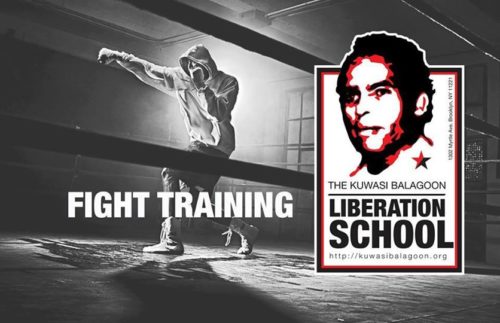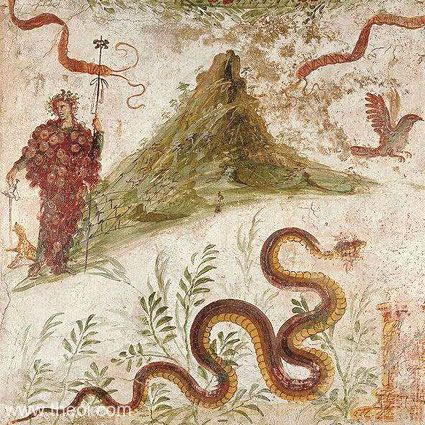![]()
In nomine Spartaci, Sibyllae, et Furoris Bacchici

The name of Spartacus has withstood over two millennia of slavery and empire, and become immortalized within the insurrectionary tradition. The personal name of his wife, “a prophetess (μαντική) subject to visitations of the Dionysiac frenzy,” has been not been passed down by the written record, but her title—the prophetess—endures, as does her source of inspiration: the Dionysiac frenzy.
The revolt which began with the prophetess, Spartacus, and a handful of his fellow gladiators lasted two years (73-71 BCE) spread across Italy to include thousands of liberated slaves, as well freeborn “herdsmen and shepherds” who joined the uprising. The rebellion terrified the Roman elite, threatening the very center of the empire both geopolitically and socially.
In the United States, slavery was never abolished: it was codified as “punishment for crime.” Against the continuation of slavery within the prison-industrial complex, the Revolutionary Abolitionist Movement (RAM) has arisen, declaring that “our struggle today must begin from this starting point” and that “the abolitionist struggle must be extended to the state and capitalism.”
Prophecy

This fresco from Pompeii reads “Spartaks” in Oscan [Istituto Poligrafico e Zecca dello Stato].
Though this is an issue of textual transmission, it rather appropriately reflects the inherent ambiguity of prophecy, even in retrospect. Some would argue that the outcome of Spartacus’ revolt was unfortunate, in that he was eventually defeated; others would argue that it was in a sense fortunate, in that he died self-liberated with sword in hand, leaving the mark of the Dionysian prophetess and frenzy upon the centuries.
Aldo Schiavone writes that if Spartacus had only intended to escape back to his native Thrace, he could have done so with a small band of fellow Thracians immediately after escaping captivity. Instead, he organized a large multi-ethnic army and stayed in Italy, repeatedly fighting against and destroying Roman legions.
Spartacus acted at a crucial moment in Roman history: Rome was preoccupied with the war against Mithridates in the east, Sertorius had recently led a revolt in Spain, there was continued armed resistance against Rome in Thrace, the social war between Rome and its Italian subjects had occurred within living memory, tensions between the poor and the rich were at an all-time high, and the vast latifundia plantation system was ripe for slave revolt and utter destruction.
Schiavone argues, based on the evidence of Spartacus’ choices to recruit an army and continually wage war against Rome rather than merely seek to go home, that “Spartacus really did try to step into the political and social vacuum” of the moment (115), and furthermore, that he did so largely because of “the magnetic pull of a wholly accepted predestination, and of a binding prophecy to respect—the mystic core of his mystery-cult beliefs…he had a destiny to fulfill, chosen by his god” (56).
Similarly, RAM, in its new book Burn Down the American Plantation, calls for a heightened sense of historical purpose and perspective grounded in the ongoing black liberation struggle against slavery, and inspired by the Rojava Revolution currently happening in Kurdish Syria:
As anti-authoritarians, we are poised at the front of the pivotal struggle of humanity…our goal is to orient the struggle, to renew a widespread commitment towards revolutionary abolitionism and to reemerge from the sidelines of history. (83)
Weapons More Suitable for Warfare
Schivaone observes that “the [gladiatorial] camp Spartacus was in would not have differed much from the two buildings uncovered at Pompeii: a cross between a prison and a fortress” (8). In 73 BCE, Spartacus and around 70 other gladiators — mostly Thracians, Gauls, and Germans — escaped their conditions of captivity. According to Plutarch, the original conspiracy had included 200 gladiators, but when their plot was betrayed, the rebel slaves were forced to act at once. Spartacus and his co-conspirators first used kitchen knives and cooking skewers to escape, and then seized a shipment of gladiatorial weapons.
“In their first actions” after their initial escape, Plutarch writes, “the gladiators drove off those who were coming out of the city of Capua and seized from them many weapons that were more suitable for warfare. They happily made the exchange, throwing away their gladiatorial armaments, which they viewed as dishonorable and barbaric.” That the rebels’ first actions were to arm themselves through expropriation from the enemy is highly significant.

Kuwasi Balagoon Liberation School fight training flyer.
In their five-point political vision, RAM lists self-defense first, describing it as “the heart of revolutionary transformation” (27). Self-defense is the rejection of the state’s monopoly on violence and the recognition that “there is no such thing as protection that one does not provide oneself” (28). RAM argues for a model that is decentralized, explicitly feminist and anti-racist, and connected to self-governing neighborhood councils, in order to firmly place “the capacity for self-defense in the hands of those who need it” (34).
In Rojava, for example, while the mixed-gender YPG and women-only YPJ militias “have been formed to fight external enemies, the HPC (self-defense forces) are civilians that get arms training with the specific goal of maintaining autonomy against internal forces that might seek to consolidate power. They are volunteers who receive both political education and self-defense training” (31). Within the YPG and YPJ, in order “to maintain participation and egalitarian relationships, all fighters contribute to decision-making within units, particularly by selecting their own leaders for specific missions.”
The Capuan rebel gladiators also elected their military leaders: Spartacus, and the Gauls Crixus and Oenomaus. According to Schiavone, the rebels often divided up their forces, “both for logistical reasons and in order to secure better control of the territory and a greater chance of finding new recruits” (134). However, the columns would maintain close communication with one another. Thus, out of logistical and strategic concerns, a certain amount of decentralization was necessary.
Heavily Overgrown with Wild Vines

Dionysos and serpent on Mount Vesuvius, fresco at Pompeii [National Archaeological Museum of Naples].
Furthermore, according to Sallust, the source closest in time to the actual events, many of the rural slaves who joined Spartacus “were very knowledgeable about the region and were used to making woven baskets from branches for their farm work. Because of their lack of real shields, they used this same knowledge to make small circular shields for themselves like those used by cavalrymen.”
In the words of RAM, “the process of escape and defense is an immediate imperative” (75).
The cunning of the rebels’ Vesuvian escape and victory find parallel in the maroon communities of the antebellum South, which RAM describes as “communities of indigenous people, self-freed slaves, and poor whites” (28). Just as Spartacus and his fellow rebels utilized the wild gifts of Bacchus and Vesuvius to their advantage, the maroon communities often hid themselves in swamps where they could use the terrain to their advantage against slave-catchers and state militias.
RAM outlines both short-term and long-term goals: in the long term, creating a network of abolitionist councils; in the short term, establishing the Underground Railroad once again. RAM lists aiding fugitives and migrants, establishing safe houses, setting up bail funds, and resisting ICE raids among potential immediate actions, but also reminds its readers that “the tactics are secondary to the outcome and certainly vary depending on location and resources. Generally, the abolitionist movement must do what it can to protect people who are hiding from the State, and to make it as difficult as possible for the state to continue its onslaught” (77).
Expropriation and Revolutionary Justice
Appian relates that Spartacus “divided the profits of his raiding into equal shares,” and thereby “soon attracted a very large number of followers.” Furthermore, he “did not permit merchants to import gold and silver, and he forbade his own men to acquire any. For the most part, he purchased iron and copper and did not censure those who imported these metals. For this reason, the [rebels] had large quantities of basic materials and were well supplied and able to stage frequent raids.”
In their next battle, Spartacus and the other rebels captured the enemy commander’s horse and lictors. The lictors were men who carried the fasces, which were the symbols of the authority of a Roman magistrate, whence the modern term “fascism” is derived. According to Frontinus, quoting a lost text of Livy, when Spartacus was finally defeated, the Romans recovered five fasces, 26 battle standards, and five Roman eagles (the battle standard of an entire legion, which was an enormous disgrace to lose to the enemy).
In the final battle, Spartacus is said by Plutarch to have “shouted that if he won the battle, he would have many fine horses that belonged to the enemy, but if he lost, he would have no need of a horse. With that, he killed the animal.” Horses were important in Thracian culture, and Herodotus reports that the neighboring Scythians sacrificed horses at the funerals of kings. Speaking of funerary sacrifices, according to Appian, when Spartacus’s Gaulish co-commander Crixus was killed in battle, he sacrificed 300 Roman soldiers as an offering to Crixus’ shade. Florus reports that the soldiers were forced to fight as gladiators, thus avenging Crixus’ experiences in life.
The Revolutionary Abolitionist Movement, in its political vision, lists as important principles “conflict resolution and revolutionary justice” and “ownership through use, the cooperative economy and expropriation.” Concerning revolutionary justice, RAM writes: “the methods of this justice are a far cry from the methods we reserve for those within our revolutionary groups, and our own communities. This line is clearly demarcated by the division between the oppressed versus the oppressor. For the oppressor, we have nothing but antagonism and struggle; for the oppressed, we have nothing but understanding and compassion” (43). We can see a similar logic at work in Spartacus’ implacable hostility towards his enemies and his loyalty towards his allies.
Spartacus’ equal division of loot is an excellent example of the communalization of expropriated wealth, and his rules banning gold and silver and instead importing iron and copper show a clear tendency towards “ownership through use” rather than ownership for the sake of profit. The seizure of Roman eagles, fasces, and battle-standards also add a spiritual dimension to the concept of expropriation.
Abolition of Gender
Drawing inspiration from Harriet Tubman, Assata Shakur, Mujeres Libres in the Spanish Civil War, and the Kurdish YPJ and Yezidi Women’s Units, the Revolutionary Abolitionist Movement argues that “the process of undoing gender roles can be viewed as similar to the process of dismantling the carceral state. Putting self-defense at the origin of this process has the potential of both building strength and uprooting stagnant roles” (62).
They note that “when people have the opportunity to autonomously defend themselves, and fight for others, the normativity of fixed identities are called into question, and the process of abolishing gender, and creating a fluid world of self-determination becomes possible” (62).
The ancient sources on the involvement of women in the revolt led by Spartacus are scarce, but Plutarch relates that the prophetess escaped together with Spartacus and the other gladiators, and Sallust reports that Gaulish women accompanied the rebel army as well. Given the prophetess’ relationship to Dionysos (and/or a Thracian deity syncretized to Dionysos), it is important to note that in 186 BCE, the Roman Senate had banned any Bacchic cult larger than “five men or women,” and decreeing that “no man or woman whosoever be a chief officer of the cult.” The decrees, surviving on a bronze plaque in Southern Italy, show that in the Bacchic cults, men and women worshiped together, and that women held leadership positions.
The decrees also forbid anyone “to swear an oath among themselves or to make a common vow or to form any pacts or make promises in common,” showing the senate’s fear of the conspiratorial and rebellious potential of the Bacchanalia. It seems likely that the prophetess and other women played important roles in the uprising of 73-71 BCE, though the details are not recorded.
Martyrs
Appian reports that Spartacus died in battle and that “his body was never found,” but that Crassus captured six thousand rebels and had them “crucified along the whole length of the highway that ran from Capua to Rome.” Brent D. Shaw notes in Spartacus and the Slave Wars: A Brief History with Documents that “the distance was about 125 miles, so there would have been one body of a crucified slave raised on a cross every 35 to 40 yards along the entire distance of the road” (144).

“The Cursed Field (Executed Slaves)” by Fedor Bronnikov, 1878 [public domain].
In the closing words of Burn Down the American Plantation, RAM swears an oath to the ancestors and the dead, and to those struggling today:
We promise to all those who have previously risked everything for liberation, who have lived and died under the oppressive yoke of this country, and all those still struggling for a better life, that we will put all our strength towards building communities so powerful that they will repel any attempt, from within or without, to reestablish the oppressive power of white supremacy, patriarchy, the state and capital. We will burn down the American plantation once and for all. (84)
Or, in the words of Walter Benjamin:
The final enslaved and avenging class…carries out the work of emancipation in the name of generations of downtrodden to its conclusion. This consciousness, which for a short time made itself felt in the “Spartacus,” was objectionable to social democracy from the very beginning…[Social democracy] contented itself with assigning the working-class the role of the savior of future generations. It thereby severed the sinews of its greatest power. Through this schooling the class forgot its hate as much as its spirit of sacrifice. For both nourish themselves on the picture of enslaved forebears, not on the ideal of the emancipated heirs.
* * *
The views and opinions expressed by our diverse panel of columnists and guest writers represent the many diverging perspectives held within the global Pagan, Heathen and polytheist communities, but do not necessarily reflect the views of The Wild Hunt Inc. or its management.
The Wild Hunt is not responsible for links to external content.
To join a conversation on this post:
Visit our The Wild Hunt subreddit! Point your favorite browser to https://www.reddit.com/r/The_Wild_Hunt_News/, then click “JOIN”. Make sure to click the bell, too, to be notified of new articles posted to our subreddit.
Pingback: TWH: Spartacus and the Revolutionary Abolitionist Movement | Heathen Chinese